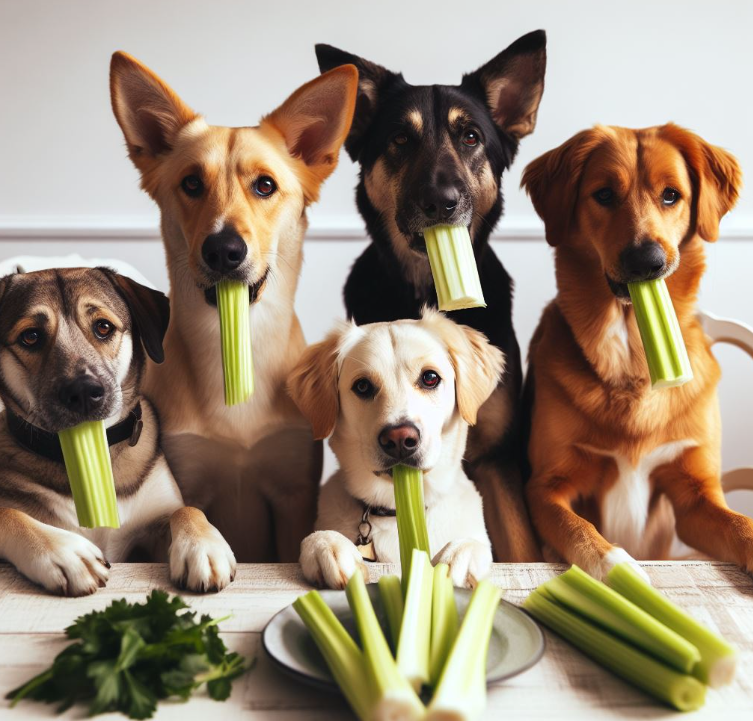Celery, a crispy and refreshing vegetable, has gained popularity among health-conscious humans. But what about our furry friends? Can dogs eat celery? In this article, we’ll delve into the world of canine nutrition and explore the benefits and potential risks of feeding celery to your beloved pet.
Table of Contents
- Introduction
- Can Dogs Have Celery?
- Risks of Feeding Celery to Dogs
- How to Prepare Celery for Your Dog
- Serving Size and Frequency
- Alternatives to Celery for Dogs
- Conclusion
- FAQs
Introduction
Dogs are not just our pets, they are an integral part of our families. We always want the best for our furry companions, and this includes making sure they have a balanced diet. But can dogs eat celery? In this article, we will explore the nutritional value of celery for dogs, its benefits, and potential risks. We will also discuss how to prepare and serve celery to your canine friend.
Can Dogs Have Celery?

Many dog owners are curious about whether celery is a safe addition to their furry friend’s diet. Celery, with its crunchy texture and low-calorie nature, is a common vegetable in human meals. But what about dogs? Let’s explore whether celery is a safe choice for your canine companion.
The Nutritional Value of Celery: Celery is not just a watery and crunchy snack; it also comes with a range of essential nutrients. It contains vitamins such as vitamin K, vitamin A, and vitamin C, all of which can be beneficial for dogs, much like they are for humans. Additionally, celery is rich in minerals like potassium and folate, which contribute to overall canine health. These nutrients play a critical role in supporting proper growth and well-being.
Low in Calories: One significant advantage of celery is its low-calorie content. This makes it an appealing option, especially for dogs with weight management concerns. Offering celery as an occasional treat can help your dog feel full without the burden of excessive calories, making it a healthier alternative to high-calorie dog treats.
Fiber for Digestion: Celery is a good source of dietary fiber, which is essential for maintaining healthy digestion in dogs, just as it is for humans. Dietary fiber can help prevent constipation and ensure the smooth operation of your dog’s digestive system. Introducing small amounts of celery into your dog’s diet can contribute to better digestion.
Chewing and Dental Health: Besides its nutritional benefits, the act of chewing celery can provide dental advantages for your dog. The crunchiness of celery can help remove plaque and tartar from your dog’s teeth, promoting better oral health. However, it’s essential to remember that while celery can support dental health, it should not replace regular toothbrushing or professional dental care for your pet.
Risks of Feeding Celery to Dogs

While celery offers certain nutritional benefits for dogs, it’s important to be aware of the potential risks associated with including this vegetable in your canine companion’s diet. Here, we’ll explore the risks to help you make informed decisions about feeding celery to your dog.
Choking Hazard: One of the primary risks associated with celery is its potential to pose a choking hazard, especially for small dogs or those that tend to swallow their food without thorough chewing. The stringy and fibrous nature of celery makes it more likely to get lodged in a dog’s throat. To mitigate this risk, always cut celery into small, bite-sized pieces, ensuring that they are manageable for your dog to chew and swallow safely.
Digestive Difficulties: The tough, stringy fibers in celery can sometimes be challenging for dogs to digest. This can lead to gastrointestinal discomfort, including stomach upset, gas, or diarrhea. While some dogs may tolerate celery without any issues, others may have sensitivities to it. It’s essential to monitor your dog’s reaction when introducing celery to their diet. If you notice any digestive problems, it may be best to avoid celery or try different methods of preparation.
Allergies and Sensitivities: Just like with any food, some dogs may have allergies or sensitivities to celery. Signs of an adverse reaction can include itching, skin rashes, or digestive disturbances. If you suspect that your dog may have a celery allergy, it’s advisable to consult with your veterinarian to confirm the diagnosis and explore suitable dietary alternatives.
Excessive Consumption: While celery is a healthy treat, excessive consumption can lead to imbalances in your dog’s diet. As with any treat, it’s crucial to offer celery in moderation. Replacing a significant portion of your dog’s regular diet with celery may result in a lack of essential nutrients found in balanced dog food. Always consider celery as an occasional treat rather than a staple food source.
Obesity Risk: Feeding too many calorie-rich treats, even if they’re healthy like celery, can contribute to obesity in dogs. This can have detrimental effects on your dog’s overall health, including increased risks of joint problems and certain medical conditions. It’s important to keep track of your dog’s calorie intake and ensure that treats, including celery, do not exceed their daily recommended calorie allowance.
How to Prepare Celery for Your Dog

Introducing celery into your dog’s diet can be a healthy and enjoyable addition, but proper preparation is essential to ensure their safety and well-being. Here’s a step-by-step guide on how to prepare celery for your dog:
1. Thoroughly Wash the Celery: Start by washing the celery stalks thoroughly under running water. This helps remove any dirt, pesticides, or chemicals that may be present on the surface. Ensuring that the celery is clean is the first step in making it safe for your dog.
2. Cut into Small, Bite-Sized Pieces: To reduce the risk of choking, it’s crucial to cut the celery into small, manageable pieces. Aim for bite-sized portions that are easy for your dog to chew and swallow. Slicing the celery into small rounds is a good option.
3. Steam or Boil for Easier Digestion (Optional): While some dogs can handle raw celery, others may find it easier to digest when it’s slightly cooked. Steaming or boiling celery can soften it, making it gentler on your dog’s stomach. If your dog has a sensitive digestive system, consider using this preparation method.
4. Avoid Seasonings and Additives: When preparing celery for your dog, avoid adding any seasonings, salt, or other additives. Dogs should consume celery in its natural form without additional flavorings. Seasonings and additives can be harmful to dogs and may upset their stomach.
5. Offer Celery as an Occasional Treat: Celery should be considered an occasional treat rather than a primary food source for your dog. While it offers health benefits, it should not replace their regular, balanced diet. Moderation is key to maintaining a healthy diet for your pet.
6. Monitor Your Dog’s Reaction: When introducing celery to your dog’s diet, closely monitor their reaction. Some dogs may take to it immediately, while others may need some time to adjust. If you notice any digestive issues or adverse reactions, consult your veterinarian to determine if celery is suitable for your dog.
7. Be Mindful of Quantity: The quantity of celery you offer your dog should be proportionate to their size, age, and dietary needs. Consult with your veterinarian to determine an appropriate serving size for your specific dog.
8. Store Celery Properly: Store celery in the refrigerator to keep it fresh. If you’ve cooked the celery, store it in an airtight container. Ensure that your dog cannot access the celery without your supervision to prevent overconsumption.
9. Mix with Other Dog-Friendly Foods (Optional): You can mix small pieces of celery with other dog-friendly foods, such as carrots or green beans, to create a tasty and healthy snack. This can make the celery more appealing to your dog.
Serving Size and Frequency

When it comes to feeding celery to your dog, it’s essential to pay attention to the serving size and frequency. While celery can be a healthy addition to your dog’s diet, it should be offered in moderation to ensure their safety and overall well-being. Here are some guidelines for serving size and frequency:
1. Serving Size:
The appropriate serving size of celery for your dog depends on several factors, including their size, age, and individual dietary needs. Here are some general recommendations:
- Small Dog Breeds: For small dog breeds, such as Chihuahuas or Yorkshire Terriers, a small piece of celery or a few slices per serving is sufficient.
- Medium Dog Breeds: Medium-sized dogs like Beagles or Bulldogs can safely consume a bit more celery, usually a few small stalks or slices.
- Large Dog Breeds: Larger breeds such as Labrador Retrievers or German Shepherds can have a larger serving of celery, but it should still be provided in moderation. About half a stalk or more can be considered a serving.
2. Frequency:
Celery should be treated as an occasional treat rather than a daily or regular part of your dog’s diet. Here are some guidelines for how often you can offer celery to your dog:
- Occasional Treat: It’s best to offer celery as an occasional treat, not more than a few times a week. This frequency ensures that your dog receives the health benefits of celery without overloading their system with this particular vegetable.
- Monitor Reaction: When introducing celery to your dog’s diet for the first time, observe their reaction. If they have no adverse effects and seem to enjoy it, you can continue to include it as an occasional treat.
- Balanced Diet: Celery should not replace your dog’s regular, balanced dog food. Ensure that your dog’s primary diet includes all the essential nutrients they need for optimal health.
3. Individual Variations:
Keep in mind that every dog is unique. Some dogs may have allergies or sensitivities to celery, while others may not enjoy the taste. Pay attention to your dog’s individual preferences and any signs of adverse reactions. If your dog experiences digestive issues or allergies, it’s best to consult your veterinarian to determine the most suitable diet for your pet.
4. Consult Your Veterinarian:
If you have specific concerns about your dog’s diet or how to incorporate celery, don’t hesitate to consult your veterinarian. They can provide personalized recommendations based on your dog’s health, size, and dietary requirements.
Alternatives to Celery for Dogs

If your dog is not a fan of celery, or if you have concerns about its potential risks, there are plenty of other dog-friendly vegetables and treats you can consider. Here are some alternatives to celery that can be both safe and nutritious for your canine companion:
1. Carrots: Carrots are an excellent alternative to celery. They are low in calories, high in fiber, and provide essential vitamins and minerals. Many dogs enjoy the sweet and crunchy texture of carrots. You can serve them raw, steamed, or even frozen for a refreshing treat.
2. Cucumbers: Cucumbers are another low-calorie and hydrating option for dogs. They are especially great for dogs on a diet or those who need to shed a few pounds. Cucumbers can be served fresh, without seeds, and sliced into small pieces.
3. Green Beans: Green beans are rich in fiber and low in calories, making them a healthy snack for dogs. They are often used as a training treat or to help with weight management. You can serve them fresh, steamed, or even frozen.
4. Sweet Potatoes: Sweet potatoes are packed with vitamins, minerals, and dietary fiber. They can be served to dogs after baking or steaming, without any seasoning. Many dogs find sweet potatoes to be a delicious and satisfying treat.
5. Broccoli: Broccoli is a nutrient-rich vegetable that can be a great addition to your dog’s diet. It’s high in fiber, vitamins, and minerals. However, it should be served in moderation, as excessive consumption can lead to digestive discomfort.
6. Zucchini: Zucchini is low in calories and provides vitamins and minerals. Dogs often find it appealing due to its mild taste and crunchy texture. You can serve it raw or lightly steamed.
7. Apples: Apples are a tasty and nutritious fruit that many dogs enjoy. However, be sure to remove the seeds and core before offering them to your pet. Apples should be served in small, bite-sized pieces.
8. Blueberries: Blueberries are rich in antioxidants and can serve as a healthy and delicious treat for your dog. They are small and convenient for training or as a small reward.
9. Pumpkin: Plain, canned pumpkin (not pumpkin pie filling) can be beneficial for dogs. It’s a good source of fiber and can help with digestive issues. A small spoonful can be added to your dog’s food or offered as a treat.
10. Watermelon: Watermelon is a refreshing and hydrating option for dogs, especially during hot weather. Ensure there are no seeds or rind, and offer it in small, seedless, and bite-sized pieces.
Conclusion
Dogs can eat celery in moderation. This vegetable offers several health benefits but also carries some risks, such as choking hazards and digestive difficulties. To ensure your dog’s safety and well-being, always prepare celery in a dog-friendly manner and feed it in small quantities.
If you are Interested or Even Want to Make Your Own Medicinal Garden In Your Backyard, just click the link.
GUIDE TO BUILD YOUR OWN MEDICINE GARDEN IN YOUR BACKYARD
FAQs
1. Can all dogs eat celery? Not all dogs are the same. Some may have allergies or digestive issues, so it’s essential to introduce celery cautiously. Consult your veterinarian if you have concerns.
2. How should I prepare celery for my dog? To make celery safe for dogs, wash it thoroughly, cut it into small pieces, and consider steaming or boiling it to aid digestion.
3. How much celery can I give to my dog? Celery should be an occasional treat and not a significant part of your dog’s diet. The quantity will depend on your dog’s size and overall diet.
4. Are there other vegetables that dogs can eat safely? Yes, carrots, cucumbers, and green beans are alternative vegetables that are generally safe for dogs.
5. What if my dog chokes on celery? If your dog chokes on celery or any other food, it’s essential to know pet CPR and the Heimlich maneuver for dogs. Seek immediate veterinary care if choking occurs.
